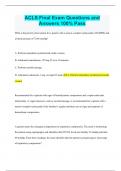ACLS Final Exam Questions and
Answers 100% Pass
What is the priority intervention for a patient with a narrow-complex tachycardia (160 BPM) and
a blood pressure of 72/48 mmHg?
A. Perform immediate synchronized cardio version
B. Administer amiodarone, 150 mg IV over 10 minutes
C. Perform carotid massage
D. Administer adenosine, 6 mg via rapid IV push ✔✔A. Perform immediate synchronized cardio
version
Recommended for a aptient with signs of hemodynamic compromise and a superventricualr
tachycardia. A vagal maneuver, such as carotid massage, is recommended for a aptient with a
narrow-complex tachycardia if the rhythm is regular and there are no signs and syptoms of
hemodynaic compromise.
A patient enters the emergency department in respiratory compromise. The team is monitoring
the patient using capnography and identifies that ETCO2 levels are initially 33 mmHg and alter
40 mmHg. From these readings, the team identifies that the patient is progressing in what stage
of respiratory compromise?
,A. Respiratory distress
B. Respiratory arrest
C. Respiratory failure
D. Respiratory acidosis ✔✔A. Respiratory Distress
The ECG rhythm strip of a patient who arrived in the emergency department complaining of
dizziness, syncope and shortness of breath reveals sinus bradycardia. When reviewing the
patients medical history, the healthcare provider identifies which agent(s) as a potential cause of
the patient's current condition?
A. Metoprolol
B. Verapamil
C. Digoxin
D. Quinapril
E. Losartan ✔✔A. Metoprolol
B. Verapail
C. Digoxin
, Which statements accurately reflect the recommendations for post-cardiac arrest
neuroprognostication?
A. Status epilepticus can be used to accurately predict a poor neurologic outcome
B. Decision making related to the continuation or withdrawal of life-sustaining treatments should
be delayed until 72 hours after ROSC and following return of normothermia
C. Post-cardiac arrest neuroprognostication should be multimodal
D. Brain imaging studies do not provide useful information for predicting neurologic outcome in
the post-cardiac arrest patient ✔✔B & C
Which areas are evaluated using the National Institute of Health Stroke Scale (NIHSS)?
A. Hearing
B. Visual function
C. Facial palsy
D. Level of consciousness
E. Language deficits ✔✔B, C, D, E
Answers 100% Pass
What is the priority intervention for a patient with a narrow-complex tachycardia (160 BPM) and
a blood pressure of 72/48 mmHg?
A. Perform immediate synchronized cardio version
B. Administer amiodarone, 150 mg IV over 10 minutes
C. Perform carotid massage
D. Administer adenosine, 6 mg via rapid IV push ✔✔A. Perform immediate synchronized cardio
version
Recommended for a aptient with signs of hemodynamic compromise and a superventricualr
tachycardia. A vagal maneuver, such as carotid massage, is recommended for a aptient with a
narrow-complex tachycardia if the rhythm is regular and there are no signs and syptoms of
hemodynaic compromise.
A patient enters the emergency department in respiratory compromise. The team is monitoring
the patient using capnography and identifies that ETCO2 levels are initially 33 mmHg and alter
40 mmHg. From these readings, the team identifies that the patient is progressing in what stage
of respiratory compromise?
,A. Respiratory distress
B. Respiratory arrest
C. Respiratory failure
D. Respiratory acidosis ✔✔A. Respiratory Distress
The ECG rhythm strip of a patient who arrived in the emergency department complaining of
dizziness, syncope and shortness of breath reveals sinus bradycardia. When reviewing the
patients medical history, the healthcare provider identifies which agent(s) as a potential cause of
the patient's current condition?
A. Metoprolol
B. Verapamil
C. Digoxin
D. Quinapril
E. Losartan ✔✔A. Metoprolol
B. Verapail
C. Digoxin
, Which statements accurately reflect the recommendations for post-cardiac arrest
neuroprognostication?
A. Status epilepticus can be used to accurately predict a poor neurologic outcome
B. Decision making related to the continuation or withdrawal of life-sustaining treatments should
be delayed until 72 hours after ROSC and following return of normothermia
C. Post-cardiac arrest neuroprognostication should be multimodal
D. Brain imaging studies do not provide useful information for predicting neurologic outcome in
the post-cardiac arrest patient ✔✔B & C
Which areas are evaluated using the National Institute of Health Stroke Scale (NIHSS)?
A. Hearing
B. Visual function
C. Facial palsy
D. Level of consciousness
E. Language deficits ✔✔B, C, D, E











